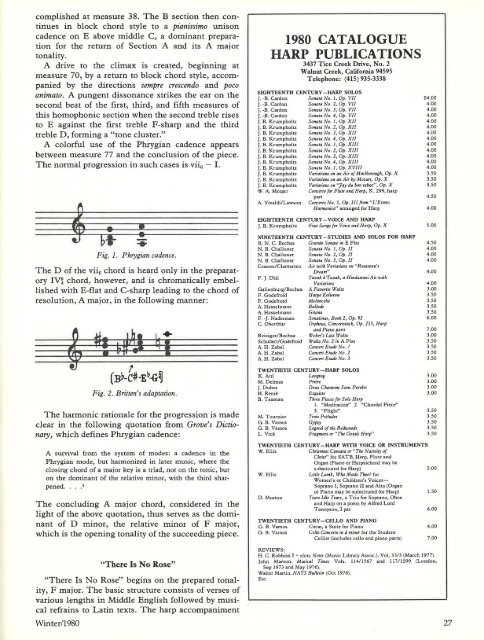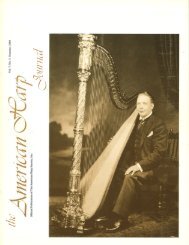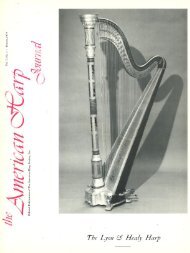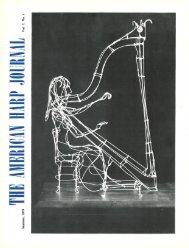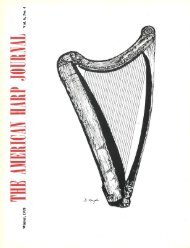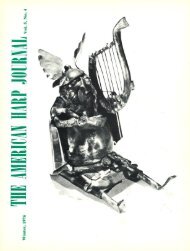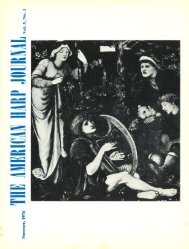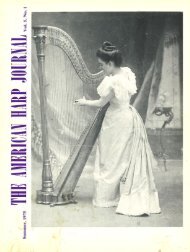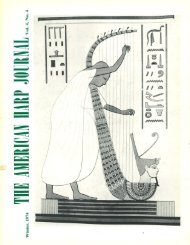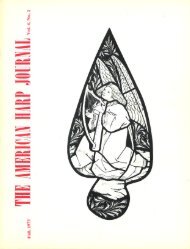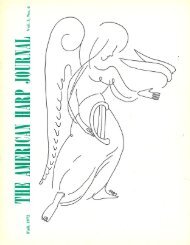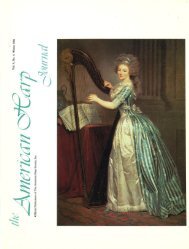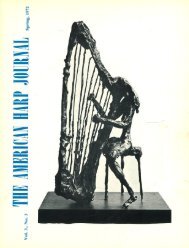You also want an ePaper? Increase the reach of your titles
YUMPU automatically turns print PDFs into web optimized ePapers that Google loves.
complished at measure 38. The B section then continues<br />
in block chord style to a pianissimo unison<br />
cadence on E above middle C, a dominant preparation<br />
for the return of Section A and its A major<br />
tonality.<br />
A drive to the climax is created, beginning at<br />
measure 70, by a return to block chord style, accompanied<br />
by the directions sempre crescendo and poco<br />
animato. A pungent dissonance strikes the ear on the<br />
second beat of the first, third, and fifth measures of<br />
this homophonic section when the second treble rises<br />
to E against the first treble F-sharp and the third<br />
treble D, forming a "tone cluster."<br />
A colorful use of the Phrygian cadence appears<br />
between measure 77 and the conclusion of the piece.<br />
The normal progression in such cases is vii 6 - I.<br />
:<br />
Fig. 1. Phrygian cadence.<br />
The D of the vii 6 chord is heard only in the preparatory<br />
IV~ chord, however, and is chromatically embellished<br />
with E-flat and C-sharp leading to the chord of<br />
resolution, A major, in the following manner:<br />
Fig. 2. Britten's adaptation.<br />
The harmonic rationale for the progression is made<br />
clear in the following quotation from Grove's Dictionary,<br />
which defines Phrygian cadence:<br />
A survival from the system of modes: a cadence in the<br />
Phrygian mode, but harmonized in later music, where the<br />
closing chord of a major key is a triad, not on the tonic, but<br />
on the dominant of the relative minor, with the third sharpened<br />
... .3<br />
The concluding A major chord, considered in the<br />
light of the above quotation, thus serves as the dominant<br />
of D minor, the relative minor of F major,<br />
which is the opening tonality of the succeeding piece.<br />
"There Is <strong>No</strong> Rose"<br />
"There Is <strong>No</strong> Rose" begins on the prepared tonality,<br />
F major. The basic structure consists of verses of<br />
various lengths in Middle English followed by musical<br />
refrains to Latin texts. The harp accompaniment<br />
<strong>Winter</strong>/<strong>1980</strong><br />
<strong>1980</strong> CATALOGUE<br />
HARP PUBLICATIONS<br />
3437 Tice Creek Drive, <strong>No</strong>. 2<br />
Walnut Creek, California 94595<br />
Telephone: (415) 935-3338<br />
EIGHTEENTH CENTURY -HARP SOLOS<br />
J. -B. Cardon Sonata <strong>No</strong>. 1, Op. VII<br />
J. -B. Cardon Sonata <strong>No</strong>. 2, Op. VII<br />
]. -B . Cardon Sonata <strong>No</strong>. 3, Op. VII<br />
J. -B. Cardon Sonata <strong>No</strong>. 4, Op. VII<br />
J. B. Krumpholtz Sonata <strong>No</strong>. 1, Op , XII<br />
J. B. Krumpholtz Sonata <strong>No</strong>. 2, Op , XII<br />
J. B. Krumpholtz Sonata <strong>No</strong>. 3, Op XII<br />
J. B. Krumpholtz Sonata <strong>No</strong>. 4, Op, XII<br />
J. B. Krumpholtz Sonata <strong>No</strong>. 1, Op. XIII<br />
J, B. Krumpholtz Sonata <strong>No</strong>. 2, Op. XIII<br />
J. B. Krumpholtz Sonata <strong>No</strong>. 3, Op. XIII<br />
J. B. Krumpholtz Sonata <strong>No</strong> , 4, Op. XIII<br />
J. B. Krumpholtz Sonata <strong>No</strong>. !, Op. XVIII<br />
J. B. Krumpholtz Variations on an Air of Marlborough, Op. X<br />
J. B. Krurnpholtz Van·a1ions on an Air by Mozart, Op. X<br />
J, B. Krumpholtz Variations on "Jay du bon 1abac", Op. X<br />
W A. Mozart<br />
Concerlo for Flute and Harp, K. 299, harp<br />
part<br />
A. Vivaldi/Lawson Concerto <strong>No</strong>. 5, Op. III from "L'Estero<br />
Harmonica" arranged for Harp<br />
EIGHTEENTH CENTURY-VOICE AND HARP<br />
J. B. Krumpholtz Five Songs for Voice and Harp, Op. X<br />
NINETEENTH CENTURY -STUDIES AND SOLOS FOR HARP<br />
R. N. C. Bochsa Grande Sona1e in E Flat<br />
N. B. Challoner Sonata <strong>No</strong>. 1, Op. II<br />
N. B. Challoner Sonata <strong>No</strong>. 2, Op. II<br />
N. B. Challoner Sonata <strong>No</strong>. 3, Op. II<br />
Cramer/Chatterton Air wilh Variations on "Rousseau's<br />
Dream"<br />
F. J. Dizi Tazah b'Tazah, a Hindustani Air with<br />
Varialions<br />
Gallenburg/Bochsa A Favorite WalLZ<br />
F. Godefroid Harpe Eolienne<br />
F. Godefroid Melancolie<br />
A. Hasselmans Ballade<br />
A. Hasselmans Gitana<br />
F. -J. Naderman Sonatinas, Book 2, Op. 92<br />
C. Oberthtir Orpheus, ConcertsrUCk, Op. 253, Harp<br />
and Piano parts<br />
Reisiger/Bochsa Weber's Lase Waltz<br />
Schubert/Godefroid Waltz <strong>No</strong>. 2 in A Flat<br />
A.H. Zabel Concert Erude <strong>No</strong>. 1<br />
A.H. Zabel Concert Erude <strong>No</strong>. Z<br />
A.H. Zabel Concert Etude <strong>No</strong>. 3<br />
TWENTIETH CENTURY -HARP SOLOS<br />
K. Attl Longing<br />
M. Delmas Priere<br />
J. Dubez Deux Chansons Sans Paroles<br />
H. Reni~ Esquisse<br />
B. Taxman Three Pieces for Solo Harp<br />
M. Tournier<br />
G.B. Vamos<br />
G.B. Vamos<br />
L. Vick<br />
1. .. Meditation" 2. "Chordal Piece"<br />
3. "Fligh('<br />
T rois Preludes<br />
Gypsy<br />
Legend of rhe Redwoods<br />
Fragment or "The Gemle Harp"<br />
$4.00<br />
4.00<br />
4.00<br />
4.00<br />
4 00<br />
4.00<br />
4.00<br />
4.00<br />
4.00<br />
4.00<br />
4.00<br />
4.00<br />
4.00<br />
3.50<br />
3.50<br />
3.50<br />
4.50<br />
4.00<br />
5.00<br />
4 50<br />
4.00<br />
4.00<br />
4.00<br />
4.00<br />
4.00<br />
3.00<br />
3.50<br />
3.50<br />
3.50<br />
3.50<br />
6.00<br />
7.00<br />
3.00<br />
3.50<br />
3.50<br />
3.50<br />
3.50<br />
3.00<br />
3.00<br />
3.00<br />
3.00<br />
3.50<br />
3.50<br />
3.50<br />
3.50<br />
3.50<br />
TWENTIETH CENTURY -HARP WITH VOICE OR INSTRUMENTS<br />
W. Ellis Christmas Camara or "The Na1iviry of<br />
Chrisc'' for SATB, Harp, Flute and<br />
Organ (Piano or Harpsichord may be<br />
substituted for Harp) 5,00<br />
W. Ellis Lierle Lamb, Who Made Thee? for<br />
Women's or Children's Voices-<br />
Soprano I, Soprano II and Alto (Organ<br />
or Piano may be substituted for Harp)<br />
I.SO<br />
D. Morton<br />
Tears Idle Tears, a Trio for Soprano, Oboe<br />
and Harp on a poem by Alfred Lord<br />
Tennyson, 3 pts<br />
6.00<br />
TWENTIETH CENTURY-CELLO AND PIANO<br />
G. B. Vamos Circus, a Suite for Piano<br />
G. B. Vamos Cello Concerto ind minor for the Student<br />
Cellist (includes cello and piano parts)<br />
4.00<br />
7.00<br />
REVIEWS:<br />
H. C. Robbins l ,don. <strong>No</strong>tes (Music Library Assoc.), <strong>Vol</strong>. 33/3 (March 1977).<br />
O<br />
John Ma,son. Musical Times <strong>Vol</strong>s. 114/1567 and 117/1599 (London,<br />
Sep 1973 and May 1976).<br />
Walter Manin. NATS Bulletin (Oct 1976).<br />
Etc.<br />
27


